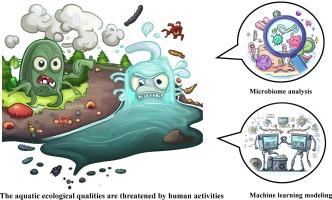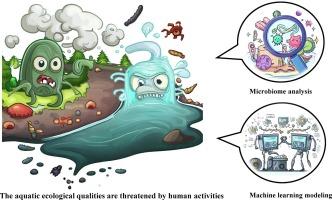基于微生物群落测序和源分类器机器学习的水污染人类活动识别
IF 9.7
1区 环境科学与生态学
Q1 ENVIRONMENTAL SCIENCES
引用次数: 0
摘要
识别和区分人类活动对于有效预防环境污染对水生生态系统和人类健康构成的威胁至关重要。机器学习(ML)是一种强大的分析工具,可以根据高通量数据集追踪人类对河流生态系统的影响。然而,以往的研究往往局限于单一的生态环境。本研究采用ML模型和16S rRNA测序数据来揭示中国各地的微生物动态和人类活动。结果表明,微生物群落主要受确定性因子(环境因子和种间相互作用)的支配,元群落划分与人类活动在水体和沉积物中均显著相关(χ 2检验w P = 1.93 × 10-22;卡方检验P = 6.00 × 10-6)。人类活动增加了种间发生网络的脆弱性,并增加了环境因素对otu组成相似性和系统发育距离的影响。结合微生物指数(mbi)、微生物相对丰度(MRA)和环境与地理指数(EGIs),采用源分类器机器学习(SCML)算法对低人为影响、农业投入、生活投入、工业投入和大坝建设5类人类活动进行分类。SCML最优配置为MBIs + MRA + EGIs, TestW R2为0.882,TestS R2为0.924,表现出优异的性能。本研究为加强生态系统管理、促进可持续水资源管理和减少污染提供了实际意义。本文章由计算机程序翻译,如有差异,请以英文原文为准。


Identifying human activities causing water pollution based on microbial community sequencing and source classifier machine learning
Identifying and differentiating human activities is crucial for effectively preventing the threats posed by environmental pollution to aquatic ecosystems and human health. Machine learning (ML) is a powerful analytical tool for tracking human impacts on river ecosystems based on high-through datasets. This study employed an ML framework and 16S rRNA sequencing data to reveal microbial dynamics and trace human activities across China. The results revealed that the microbial assembly was mainly dominated by deterministic factors (environmental factors and interactions between species), and the metacommunity partition was significantly associated with human activities in both water and sediment (Chi-square testw P = 1.93 × 10-22; Chi-square tests P = 6.00 × 10-6). Human activities increased the vulnerability of interspecific occurrence networks and the influence of environmental factors on the OTUs similarity and phylogenetic distance. Combined of microbiological indices (MBIs), microbial relative abundance (MRA), and environmental and geographical indices (EGIs), the source classifier machine learning (SCML) algorithm was used to categorize five human activities (i.e., low human-impact, agricultural inputs, domestic inputs, industrial inputs, and dam construction). The SCML optimal configuration is (MBIs + MRA + EGIs) exhibited strong performance with TestW R2 of 0.882 and TestS R2 of 0.924. This study provides valuable insights for improving ecosystem management, supporting sustainable water resource management and advancing pollution mitigation efforts.
求助全文
通过发布文献求助,成功后即可免费获取论文全文。
去求助
来源期刊

Environment International
环境科学-环境科学
CiteScore
21.90
自引率
3.40%
发文量
734
审稿时长
2.8 months
期刊介绍:
Environmental Health publishes manuscripts focusing on critical aspects of environmental and occupational medicine, including studies in toxicology and epidemiology, to illuminate the human health implications of exposure to environmental hazards. The journal adopts an open-access model and practices open peer review.
It caters to scientists and practitioners across all environmental science domains, directly or indirectly impacting human health and well-being. With a commitment to enhancing the prevention of environmentally-related health risks, Environmental Health serves as a public health journal for the community and scientists engaged in matters of public health significance concerning the environment.
 求助内容:
求助内容: 应助结果提醒方式:
应助结果提醒方式:


